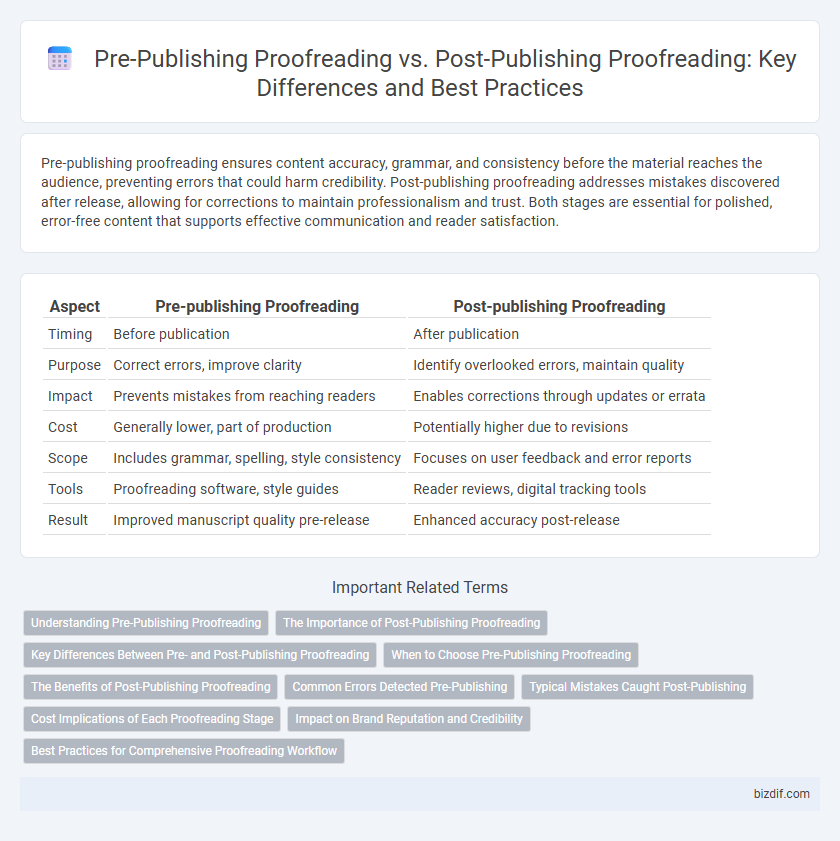Pre-publishing proofreading ensures content accuracy, grammar, and consistency before the material reaches the audience, preventing errors that could harm credibility. Post-publishing proofreading addresses mistakes discovered after release, allowing for corrections to maintain professionalism and trust. Both stages are essential for polished, error-free content that supports effective communication and reader satisfaction.
Table of Comparison
| Aspect | Pre-publishing Proofreading | Post-publishing Proofreading |
|---|---|---|
| Timing | Before publication | After publication |
| Purpose | Correct errors, improve clarity | Identify overlooked errors, maintain quality |
| Impact | Prevents mistakes from reaching readers | Enables corrections through updates or errata |
| Cost | Generally lower, part of production | Potentially higher due to revisions |
| Scope | Includes grammar, spelling, style consistency | Focuses on user feedback and error reports |
| Tools | Proofreading software, style guides | Reader reviews, digital tracking tools |
| Result | Improved manuscript quality pre-release | Enhanced accuracy post-release |
Understanding Pre-Publishing Proofreading
Pre-publishing proofreading involves meticulously reviewing a manuscript before it is released to ensure grammatical accuracy, consistency, and clarity, preventing costly errors in printed or digital content. This process helps maintain the credibility of authors and publishers by catching typos, spelling mistakes, and formatting issues that could detract from the reader's experience. Understanding pre-publishing proofreading is essential for producing polished, professional publications that uphold high editorial standards and avoid the need for errata or corrections post-publication.
The Importance of Post-Publishing Proofreading
Post-publishing proofreading plays a critical role in maintaining the accuracy and professionalism of published content by identifying and correcting errors overlooked during the initial review process. This ongoing quality control helps preserve the credibility of the author and publisher while ensuring compliance with industry standards and reader expectations. Continuous post-publishing review also allows for timely updates in response to changing information, enhancing overall content reliability and user engagement.
Key Differences Between Pre- and Post-Publishing Proofreading
Pre-publishing proofreading focuses on detecting and correcting errors in grammar, spelling, punctuation, and formatting before the final version is published, ensuring the content is polished and professional. In contrast, post-publishing proofreading involves reviewing the published material to identify any overlooked mistakes or inconsistencies, often leading to errata or updated versions. The key differences lie in timing, purpose, and impact, where pre-publishing aims for error prevention, while post-publishing manages corrections after public release.
When to Choose Pre-Publishing Proofreading
Choosing pre-publishing proofreading is essential when accuracy and a polished final product are critical before content release, such as in books, academic papers, or official reports. This process helps identify and correct grammatical errors, typos, and inconsistencies early, ensuring the published material maintains professional standards. Pre-publishing proofreading minimizes costly revisions and enhances reader credibility by delivering error-free content from the outset.
The Benefits of Post-Publishing Proofreading
Post-publishing proofreading allows for real-time error detection and correction based on reader feedback and analytics, enhancing the overall quality and credibility of the content. This process helps capture overlooked mistakes, ensuring that the published material remains accurate and trustworthy, thereby improving user engagement and brand reputation. Continuous updates from post-publishing proofreading contribute to better SEO rankings by maintaining content relevance and correctness over time.
Common Errors Detected Pre-Publishing
Pre-publishing proofreading commonly detects errors such as grammatical mistakes, typographical errors, and inconsistencies in formatting or style. It also identifies issues with clarity, sentence structure, and factual inaccuracies before the content reaches its audience. This stage ensures a polished and professional final product, reducing the need for costly corrections after publication.
Typical Mistakes Caught Post-Publishing
Post-publishing proofreading typically uncovers errors such as typographical mistakes, formatting inconsistencies, and overlooked grammatical slips that escaped pre-publishing review. These mistakes often include broken links, incorrect metadata, and misaligned images that affect user experience and SEO performance. Identifying and correcting these issues after publication is crucial for maintaining content credibility and ensuring search engine optimization effectiveness.
Cost Implications of Each Proofreading Stage
Pre-publishing proofreading often incurs higher upfront costs due to extensive manuscript review and correction before printing or digital release. Post-publishing proofreading generally involves lower direct fees but can lead to expensive consequences such as reputation damage and costly errata if errors are found after distribution. Investing in thorough pre-publishing proofreading reduces the risk of expensive revisions and protects brand integrity over time.
Impact on Brand Reputation and Credibility
Pre-publishing proofreading ensures content accuracy and professionalism, preventing errors that could damage brand reputation before reaching the audience. Post-publishing proofreading can identify and correct mistakes quickly but may still allow initial damage to credibility due to visible errors. Businesses committed to maintaining a strong brand image prioritize rigorous pre-publishing checks to uphold trust and authority in their industry.
Best Practices for Comprehensive Proofreading Workflow
Pre-publishing proofreading involves meticulous review before content goes live, ensuring grammatical accuracy, consistency, and adherence to style guides to prevent errors that could damage credibility. Post-publishing proofreading focuses on identifying and correcting mistakes after release, leveraging reader feedback and analytics to continuously improve content quality. Integrating both stages into a comprehensive proofreading workflow maximizes accuracy, optimizes content performance, and maintains audience trust across platforms.
Pre-publishing proofreading vs Post-publishing proofreading Infographic

 bizdif.com
bizdif.com